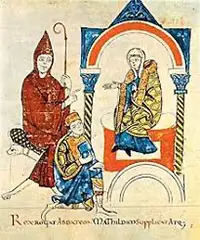The Holy Roman Empire
Part 1: Medieval Beginnings The Holy Roman Empire was a conglomeration of states and territories that held sway over much of Europe to varying degrees for nearly 1,000 years. 
Historical tradition has it that the Frankish ruler Charlemagne took the title of emperor when he was crowned King of the Franks in 800. It was not until 962, however, when one of his successors officially claimed the title of Holy Roman Emperor. That was Otto I, known as Otto the Great (left). He was King of East Francia and King of the Lombards and then, on Feb. 3, 962, Pope John XII placed the imperial crown on Otto's head. 
At that time, the entity was not referred to as "the Holy Roman Empire"; that term came into fashion a few centuries later. Rather, like Charlemagne, Otto and others regarded themselves as ruling in the fashion of the Roman emperors. Indeed, people of the time referred to it as the Roman Empire. Other names included the Christian Empire and "the whole kingdom," as opposed to various lesser kingdoms. (Indeed, the "whole kingdom," at one time or another, comprised four amorphous states: the Kingdom of Bohemia, the Kingdom of Burgundy, the Kingdom of Germany, and the Kingdom of Italy.) In terms of today's boundaries, the Holy Roman Empire contained, to varying degrees, part of what is now Austria, Belgium, the Czech Republic, France, Germany, Italy, Liechtenstein, the Netherlands, Poland, Slovenia, and Switzerland. Three emperors named Otto ruled in succession, and then a cousin, Henry II, took over. They continued the tradition of being first named King of Germany and then named King of the Romans. To each of those positions, the Ottos and Henry secured the support of various nobles; it was the pope's placing of the imperial crown on the imperial head that bestowed the title of emperor. However, being named King of the Romans came to be a prerequisite to being named Holy Roman Emperor, as so the office of emperor was essentially an elected one. And with the promise of support came the necessity, often, of quid pro quo, so those fortunate enough to be elected and then crowned found themselves, to a greater or lesser extent, beholden to those whose support they gained and so found the need to return the favor in ways large and small. 
The ascension of Conrad II in 1027 began the Salian Dynasty, which ruled for a century. One of the most powerful of these emperors was Henry IV, who famously clashed with Pope Gregory VII in the Investiture Controversy, a struggle over who had the authority to appoint church officials within the borders of the Holy Roman Empire. It was the emperor Henry V who brought some measure of peace with the Concordat of Worms, in 1122. The next dynasty to rule was the Hohenstaufen, begun by Conrad III in 1138. His successor was the famous Frederick Barbarossa. The Hohenstaufen long strove for power against their enemies the Welf, who scored one ruler of the Empire, Otto IV (1209–1215). After that interlude, Hohenstaufen rule continued, in the person of Frederick II, for a brief time and then ended, giving way to a power struggle between rivals in Germany, Holland, and Luxembourg. Ending this decadeslong political and sometimes military conflict was, eventually, the House of Habsburg, which placed a noble on the imperial throne for the better part of three centuries. Next page > Centuries of Influence > Page 1, 2 |
|
Social Studies for Kids
copyright 2002–2024
David White




